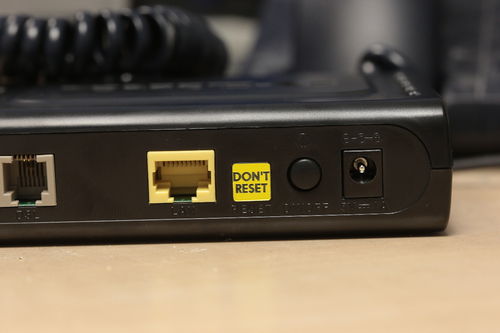Router - DLINK 320B: Difference between revisions
(→Default Settings: added section on how to poke the hole etc) |
|||
| Line 2: | Line 2: | ||
[[File:DSL_320B_D1.png]] |
[[File:DSL_320B_D1.png]] |
||
==Default |
==Default settings== |
||
{|class="wikitable" |
{|class="wikitable" |
||
!colspan="2"|Default/Factory Settings |
!colspan="2"|Default/Factory Settings |
||
| Line 15: | Line 15: | ||
|192.168.1.1 |
|192.168.1.1 |
||
|} |
|} |
||
=== Resetting the DLink DSL-320B-Z1 modem === |
|||
To reset the (currently shipping Z1 hardware variant) modem, locate the reset button hole on the rear panel of the unit. With the modem powered on, use a paperclip to hold the button down for 10 seconds. Release the button and the modem will go through its reboot process. |
|||
Wait about 30 seconds to access the router. The default IPv4 address for the modem’s http admin user interface on the LAN is 192.168.1.1/24. Your own IPv4 address will need to be in the same subnet and different from that of the modem ie set to something in the range 192.168.1.2 - .254. You can ready to log in to the web admin interface using a web browser, at http://192.168.1.1. |
|||
==Notes== |
==Notes== |
||
Revision as of 07:09, 6 December 2017
Default settings
| Default/Factory Settings | |
|---|---|
| Username: | admin |
| Password: | admin |
| IP: | 192.168.1.1 |
Resetting the DLink DSL-320B-Z1 modem
To reset the (currently shipping Z1 hardware variant) modem, locate the reset button hole on the rear panel of the unit. With the modem powered on, use a paperclip to hold the button down for 10 seconds. Release the button and the modem will go through its reboot process. Wait about 30 seconds to access the router. The default IPv4 address for the modem’s http admin user interface on the LAN is 192.168.1.1/24. Your own IPv4 address will need to be in the same subnet and different from that of the modem ie set to something in the range 192.168.1.2 - .254. You can ready to log in to the web admin interface using a web browser, at http://192.168.1.1.
Notes
- AAISP will configure these routers in bridge mode only.
- They do support 1500 MTU (unlike the Router - ZyXEL_P660R-D1).
- Their web interface is quite insecure, which is why we do not suggest customers use these in 'router' mode. They are sold by AAISP as bridge only, and the reset button is covered to protect it from being reset!
- Chipset: The currently shipping DSL-320B-Z1 units (at the time of writing, December 2017), and those shipped from approx 2015 onwards, use an old but capable MediaTek / TrendChip chipset. The older -D1 routers were Broadcom-based.
- Incorrect manufacturer’s defaults: The default settings shown in the router’s web admin user interface show defaults that are quite unsuitable. It is important to enable the ‘bitswap’ option for best reliability and performance in most cases. (See discussion of bitswap.) This default seems so odd that perhaps this is just a bug in the DLink software and the bitswap feature really defaults to ‘enabled’. (Needs a volunteer to do reliability testing to compare the two cases.)
Setting options
(Referring to the DSL-320B-Z1.) In the router’s web admin user interface, see
‘ADVANCED’ (top horiz navigation bar) > Advanced ADSL (lhs vertical navigation list)
- ANNEX A/I/J/L/M
- Bitswap - Enable (very importent)
- SRA - Enable (for future-proofing, but not supported by eg BT currently)
Performance tip for long lines: If you have an extremely long phone line (>60 dB downstream attenuation) and you can use ADSL2+, it is worthwhile experimenting with setting the DSL mode/standard option to ‘ADSL 2’ (only) in the above list of options, that is, taking ADSL2+ out of the list of allowed standards, as opposed to allowing the modem to use ADSL2+, to see if this restriction gives a performance improvement. It will be a long process to get a meaningful comparison with take many restarts and many tests to confirm any possible performance difference between allowing and disallowing ADSL2+. If in any doubt enable ADSL2+ ie ADSL1/ADSL2/ADSL2+ ‘auto’ mode where the modem will use ADSL2+ (which can support much higher best-case speeds than ADSL2) if the exchange DSLAM or MSAN supports ADSL2+ too.
Rear view of obsolete ‑D1 modem
The image below is of the older generation of routers. The currently shipping (as of December 2017) DLink DSL-320B-Z1 modems, shipping since before 2015, are completely different in appearance and also in internal hardware and software.

